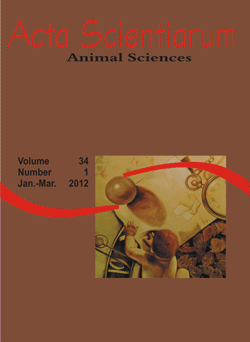<b>Heterogeneous genetic (co)variances in simulated closed herds under selection</b> - 10.4025/actascianimsci.v34i1.10934
Abstract
Assuming that selection in closed herds can promote reduction in additive genetic variance, multiple regression models were used to estimate this change in additive genetic (co)variance component, over the years when the selection was done. Weights at 550 days (W550) were studied using simulated data of herds submitted to 20 years of selection. (Co)variance components were estimated assuming that the weight at 550 days was a new trait every five years, by multiple-trait analyses involving four traits in the animal model. Three multiple regression equations were fitted—RMI, RMM, RMF—estimating thus the additive genetic (co)variance components for the 20 years of selection and eight years prior to the selection process. The initial years of each generation of selection were used as a covariate in the RMI. In the RMM, intermediate years were used, and the final years were considered in the RMF. The equations showed high coefficients of determination. However, there was no difference in the adjustment between the models. It was observed that the multiple regression models can be used in the estimation of genetic (co)variance components, when heteroscedasticity is assumed over time due to the selection process.Downloads
Download data is not yet available.
Published
2011-06-09
How to Cite
Lino-Lourenço, D. A., Oliveira, C. A. L. de, Martins, E. N., Leite, M. C. de P., Maia, F. M. C., & Santos, A. I. dos. (2011). <b>Heterogeneous genetic (co)variances in simulated closed herds under selection</b> - 10.4025/actascianimsci.v34i1.10934. Acta Scientiarum. Animal Sciences, 34(1), 83-90. https://doi.org/10.4025/actascianimsci.v34i1.10934
Issue
Section
Animal Breeding and Reproduction
DECLARATION OF ORIGINALITY AND COPYRIGHTS
- I Declare that current article is original and has not been submitted for publication, in part or in whole, to any other national or international journal.
The copyrights belong exclusively to the authors. Published content is licensed under Creative Commons Attribution 4.0 (CC BY 4.0) guidelines, which allows sharing (copy and distribution of the material in any medium or format) and adaptation (remix, transform, and build upon the material) for any purpose, even commercially, under the terms of attribution.
Read this link for further information on how to use CC BY 4.0 properly.
0.9
2019CiteScore
29th percentile
Powered by 








































